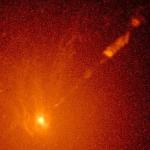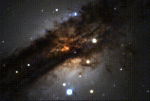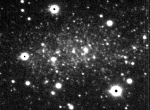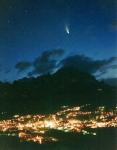
|
Astronomy Picture Of the Day (APOD)
 Mercury Astronauts and a Redstone
Mercury Astronauts and a Redstone
6.04.1997
Space suited project Mercury astronauts John H. Glenn, Virgil I. Grissom, and Alan B. Shepard Jr. (left to right) are pictured here posing in front of a Redstone rocket in this vintage 1961 NASA publicity photo. Project Mercury was the first U.S. program designed to put humans in space.
 A Black Hole in M87?
A Black Hole in M87?
5.04.1997
The center of nearby giant galaxy M87 is a dense and violent place. In this 1994 photograph by the Hubble Space Telescope, a disk of hot gas was found to be orbiting at the center of this massive elliptical galaxy. The disk is evident at the lower left of the picture.
 Hale-Bopp in Stereo
Hale-Bopp in Stereo
4.04.1997
This stereo pair of Hale-Bopp images combines two pictures from slightly different viewing angles. Simulating stereo vision, the difference was generated by the comet's apparent motion as it cruised through the inner Solar System.
 Earth, Clouds, Sky, Comet
Earth, Clouds, Sky, Comet
3.04.1997
Does a comet's dust tail always orbit behind it? Since comets rotate, they shed gas and dust in all directions equally. Small ice and dust particles expelled by the comet, however, are literally pushed around by sunlight. The smaller the particle, the greater the effect.
 A Complete Aurora
A Complete Aurora
2.04.1997
Aurora frequently make complete rings around a pole of the Earth. This particular "crown", visible in orange near the top of this image, was taken by the orbiting Polar spacecraft about one year ago and released by NASA last month.
 Hale-Bopp and Andromeda
Hale-Bopp and Andromeda
1.04.1997
Which is closer: the comet or the galaxy? Answer: the comet. In its trek through the inner Solar System, Comet Hale-Bopp has passed nearly in front of the Andromeda Galaxy (M31), seen on the lower left.
 NGC 3242: The 'Ghost of Jupiter' Planetary Nebula
NGC 3242: The 'Ghost of Jupiter' Planetary Nebula
31.03.1997
It's a weed, it's Jupiter, no it's - actually planetary nebula NGC 3242. After a star like our Sun completes fusion in its core, it throws off its outer layers it a striking display called a planetary nebula.
 Dusty Galaxy Centaurus A
Dusty Galaxy Centaurus A
30.03.1997
One of the most unusual galaxies known, Centaurus A, is pictured above. Cen A is marked by dramatic dust lanes that run across the galaxy's center. These dust lanes are so thick they almost completely obscure the galaxy's center in visible light.
 The Closest Galaxy: The Sagittarius Dwarf
The Closest Galaxy: The Sagittarius Dwarf
29.03.1997
What's the closest galaxy to our Milky Way? For many years astronomers thought it was the Large Magellanic Cloud (LMC). But the seemingly insignificant fuzzy patch shown above turned out to be part of a galaxy that is even closer.
 A Comet In The Sky
A Comet In The Sky
28.03.1997
It has been suggested that Comet Hale-Bopp will become the most viewed comet in Human history. Presently, for denizens of the Earth's northern hemisphere, this bright comet is certainly a lovely and inspiring sight -- visible here crowning the sky above Cortina d'Ampezzo, Italy on March 20.
|
January February March April |
|||||||||||||||||||||||||||||||||||||||||||||||||